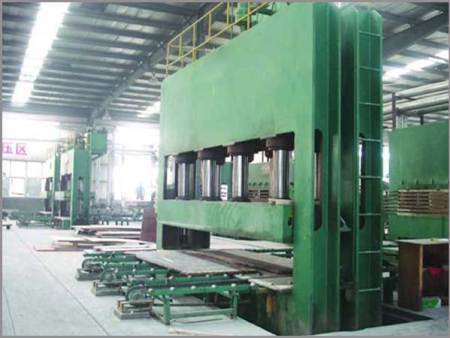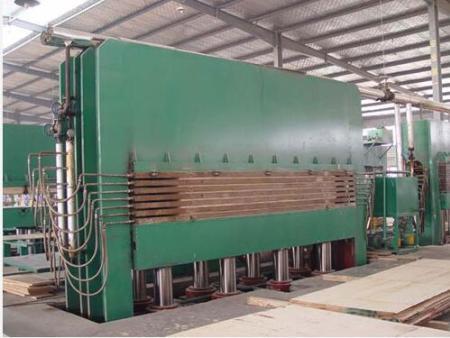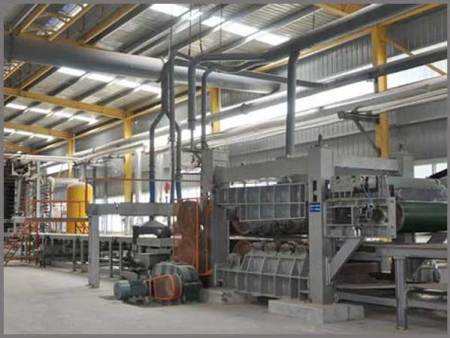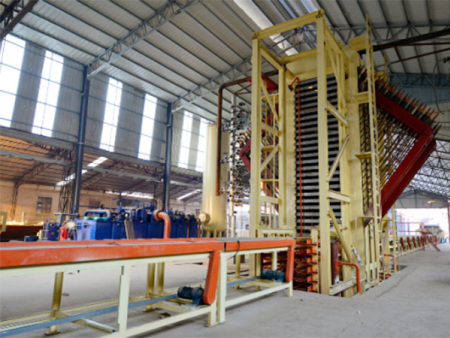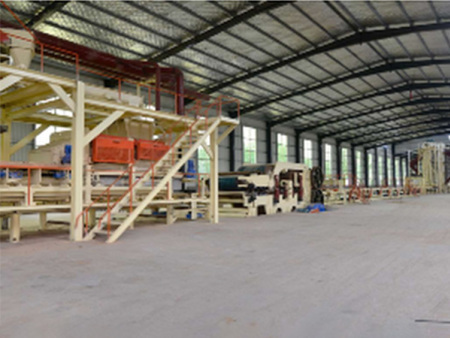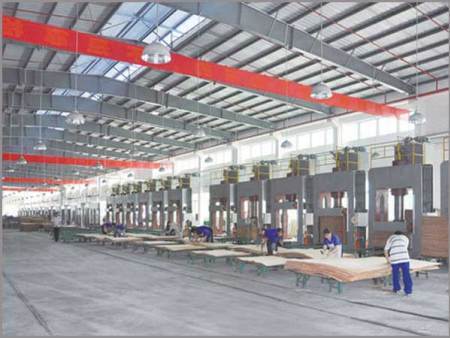I.Overview
Medium-density fiberboard is made of wood fibers or other plant fibers as raw materials,and is pressed through the main processes of fiber preparation,sizing,waxing,drying,forming,hot pressing,sawing and sanding,which is"like wood but better than wood".Man-made panels.Its products are widely used in industries such as furniture manufacturing,construction,interior decoration,interior decoration of vehicles and ships,and housings of household appliances.
(2)Production Guidelines
1.Product type:dry-process wooden medium density fiberboard.
2.Production scale:50000m3/a.
3.Product specifications:length×width×thickness=2440×1220×(8~25)mm.
Density 0.64~0.88g/cm3.
4.Adhesive:low molar ratio urea-formaldehyde resin glue(solid content 50±1%).
5.Product quality standards:The product quality is in compliance with the China Medium Density Fiberboard Standard(GB/T11718-1999).
6.Work system:
Number of working days per year:300 days/year.
Number of working shifts per day:3 shifts/day(including 2 shifts for material preparation and sanding).
Shift working hours:8 hours/shift(effective working hours 7.5 hours/shift).
7.Workshop composition
This production line is divided into five production sections:
A material preparation section:including chipping,wood chip screening,wood chip storage and other processes.
B fiber preparation section:including heat milling(fiber separation),fiber drying and metering processes.
D glue adjustment and sizing section:including the storage,measurement and application of waterproofing agent;the storage,preparation,measurement and application of glue.
E forming,hot pressing,cooling section:including fiber conveying,storage,forming,pre-pressing,slab sawing and conveying,hot pressing,turning plate cooling and other processes.
F sanding and edge sawing section:including intermediate storage,sanding,edge sawing,inspection and other processes.
(three)production process
1.Block diagram of production process flow wax and glue
↓
Raw material→chips→wood chip storage→screening→heat grinding→
Fiber Drying→Paving Forming→Pre-compression→Slab Saw Cutting→
Hot pressing→turning plate cooling→slitting→longitudinal sawing→sanding→inspection,grading,and storage
The process flow is detailed in process flow chart GY-01.
2.Brief description of production process
1.Material preparation section
After the wood is stacked in the raw material yard,it is transported by the loading truck to the vicinity of the feeding belt conveyor,manually loaded onto the belt conveyor,and then entered into the chipper for cutting.The processed wood chips are stored in the wood chip warehouse by the spiral conveyor,the large-inclination sidewall belt conveyor,and the belt conveyor.
The discharge screw at the bottom of the wood chip bin sends the wood chips to the belt conveyor,and is sent to the screening machine for screening.Unqualified wood chips,bark,sand and other debris are screened and removed,and qualified wood chips are passed through the belt conveyor,The bucket elevator and belt conveyor enter the wood chip preheating bin.
2.Fiber preparation section
The wood chips in the preheating bin are sent to the feed screw of the heat mill by the vibrating discharging device,and the cork is formed after being extruded by the reducing screw and sent to the vertical digester for cooking and softening.The softened wood chips are sent to the grinding chamber of the heat mill through a feeder and a screw conveyor for fiber separation.The milled fibers are sent to the dryer through the fiber discharge tube for drying,and the moisture content is strictly controlled within 8-11.
The fiber is dried in the dryer pipe.The heating medium of the dryer is saturated steam.After passing through the heat exchanger,the hot air transports the wet fiber from the dryer pipe to the cyclone separator at the end of the pipe,where the humid air is separated from the fiber,and the fiber is dried to the moisture content required by the process.The discharge port of the cyclone separator is equipped with a fireproof belt conveyor.Under normal circumstances,the dried fiber will be sent to the dry fiber silo for storage by a set of pneumatic conveying device after the fireproof belt conveyor.If there is a fire alarm,the fireproof belt conveyor will automatically reverse and discharge the fibers to prevent the fibers with sparks from entering the silo.
3.Glue mixing and sizing section
After the paraffin wax is heated and melted,it is directly sprayed into the grinding chamber of the thermal mill according to a certain process ratio through a metering pump.As the fiber decomposes,the paraffin wax can be evenly attached to the fiber surface and can effectively lubricate the grinding disc..
After the rubber material and curing agent are mixed and prepared,they are sent to the discharge tube of the heat mill with a metering pump to mix them with the fibers uniformly and enter the dryer together to dry.
4.The forming,hot pressing and cooling section,the forming machine is mechanical.
The dry silo set on the upper part of the forming machine moves forward at a constant speed through the conveyor belt at the bottom,and sends the material to the discharge port.The material is forced to be thrown by the throwing roller to provide the paving head with a horizontally uniform and continuous equal amount of material flow.Under the action of a set of inclined throwing rollers in the paving head,the material flow falls more evenly on the conveyor belt of the paving line,and forms a slab of a certain thickness.A negative pressure device is installed under the forming box and the leveling roller to adjust the uniformity of the formed slab and make the slab have a certain degree of compactness.The paved slabs are sent to the pre-pressing machine by the forming belt,and then the slabs are sawed and cut to a certain size by cross-cut sawing.After detection by the metal detector,they are sent one by one by the conveyor.Into the non-backup plate loading machine,when fifteen slabs are filled,the loading trolley in the plate loading machine will send the slabs into the hot press for hot pressing.
The unqualified slabs are broken up by the slab recovery device,and then sent to the dry fiber silo by a set of pneumatic conveying device for recycling.
The hot press has 15 layers,and the heating medium is heat transfer oil.The hot press is equipped with a simultaneous closing device and a thickness gauge.Under the action of pressure and temperature,after a certain period of time,the slab is pressed to the density required by the process,and the adhesive solidifies to become a pressed mat.After the hot-pressed wool board is cooled by the plate turning cooler,it is divided into two pieces by a cross-saw,and then stacked and stored in the middle to make the adhesive fully solidify
Under the action of pressure and temperature,after a certain period of time,the slab is pressed to the density required by the process,and at the same time the adhesive solidifies to become a pressed mat.After the hot-pressed wool board is cooled by the plate turning cooler,it is divided into two pieces by a cross-saw,and then stacked and stored in the middle to make the adhesive fully solidify
There is an exhaust hood above the hot press,and the exhaust gas generated by the hot pressing is exhausted to the outside by the axial fan installed on the roof.
5.Sanding and sawing section
In order to ensure that the finished board does not appear to collapse,this section adopts the process of sanding and trimming.
The rough board is piled up for about 1 day and then enter the sanding line for sanding to sand off the pre-cured layer on the board surface and ensure its thickness tolerance requirements.
The sanded boards are cut into 4′×8′size boards by a longitudinal edge trimmer and a transverse edge trimmer.After inspection,sorting,and stacking,they are sent to the warehouse by a forklift.
The sawdust and dust produced by vertical and horizontal sawing and sanding are sent to the hot oil furnace as fuel through a set of pneumatic dust collector.
The process equipment layout is detailed in process layout drawing GY-02.
(4)Process equipment selection
China's medium-density fiberboard production has a history of more than 20 years.After years of exploration and digestion and absorption of foreign advanced technology,the production process,technology and equipment have become increasingly mature.Practice in recent years has shown that China's large and medium-scale MDF production equipment is mature and reliable,and the quality of the products produced has approached or even reached the quality of the products produced by the imported production lines.Compared with imported production lines,domestic production lines have obvious competitive advantages in terms of input-output ratio,product quality and sales price,production cost and economic benefits.Therefore,domestic equipment has been used for many MDF production Favored by the business.
Sand light is planned to adopt the configuration of"4 racks"+2 racks,which are single-sided sanding,and the equipment is made in China.This project has reached a relatively ideal level in terms of input-output ratio,product quality and price.It has the characteristics of high starting point and strong competitiveness.






